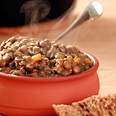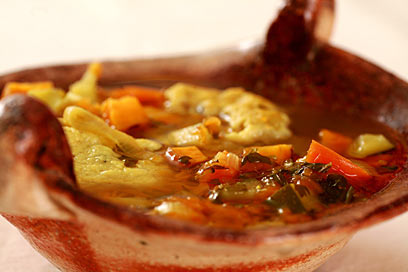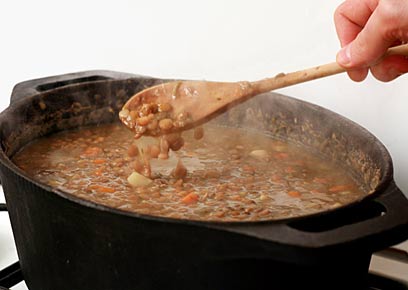
Winter seasonal food
Each season brings with it colors, flavors and scents to the table. Ancient doctors explained that food that grows in every season is exactly what our bodies need for that season to stay balanced
This winter, which has yet to arrive in full, sometimes seems like a long fall. But still, the plants feel something. Maybe it is the change in the angle of the sun beams or the changed temperature; maybe it is the difference in hours of sunlight and the lengthening nighttime. Something tells the summer fruits to stop, and signals the winter vegetables it is time to grow.
Maimonides makes an analogy between the times of day and the seasons of the year: Nighttime for him was like the winter. The night is the hardest, according to Maimonides, which is why most of us are sick at the beginning of winter. But nighttime is also a good time to snuggle up at home and rest. Get a warm drink and speak quietly.

Vegetable soup with dumplings (Photo: Assaf Ronen)
The truth of the matter is that Maimonides wrote those things about the fall, the fall of those days which is our winter. If you plan on reading ancient texts you should know the name of the seasons was reversed then, fall, “stav”, was the name of winter, and winter, “horef”, was what the fall was called.
Hebrew mistake
Dr. Aharon Geva-Kleinberg, a linguist from Haifa University, claims that the origin of the mistake is in the revivers of the Hebrew language, who were just confused.
In the bible, in Song of Songs, 2:11-13, it is written: “For, lo, the winter is past, the rain is over and gone; The flowers appear on the earth; the time of the singing of birds is come, and the voice of the turtle is heard in our land; The fig tree putteth forth her green figs, and the vines with the tender grape give a good smell…”
The original Hebrew uses the word “stav”, fall, in this passage, although according to this passage, the spring comes after the fall. In Arabic, another Semite language, the names are also opposite from the New Hebrew mistake. We will continue using the terminology we are familiar with today.
Avissena (Ibn-Sina), the famous tenth century Persian doctor, wrote that “winter is a help for the digestion.” He told of how “the cold weather embraces the unnate heat, forsters it and makes it more concentrated.”
In the winter, he says, food must be warmer and harder, grains and legumes. His suggestions might seem irrelevant to us, but seasonal changes were very significant in ancient thinking. Not only because they didn’t have running water and electricity, but also because of the enormous impact the seasons have on us. Even today our moods, activities, health and nutrition change with the seasons.

Special lentil stew (Photo: Assaf Ronen)
Except that nowadays the supermarkets offer oranges, melons and cucumbers all year round, and we tend to forget there is a specific season for every fruit and vegetable.
For those who try to eat every vegetable in season there is a certain excitement in the anticipation of the renewal which occurs every season. It is true that even organic stores have peppers, squashes and tomatoes. Even in the organic markets many vegetables are deeply frozen, and thawed out according to the marketers needs, and not according to the needs of the body.
Organic produce is also picked while green, so it will have a longer shelf life. Most of the time, however, organic produce, especially when purchased directly from the farmer, tells us the story of the seasons; a story long forgotten by the food on the supermarket shelf.
Each season brings with it colors, flavors and scents to the table. In general, the summer brings fruits, gourds and the nightshades. The winter brings the roots and the leafy greens. Ancient doctors explained that the food that grows in every season is exactly what our bodies need for that season to stay balanced.
Today we also know that the nutritional value of the produce is greatest as soon as it is picked, and that if it is picked when it is ripe, the nutritional value is further multiplied. Ancient doctors added that the food has its own “character”, and this character is exactly suited to what the body needs that season.
We choose to eat our produce in its season, when it is ripe and fresh. This is a choice which can sometimes be frustrating, because it limits the variety of products available to us. But we will still try to avoid oranges in summer and pesto in winter.
If there is a season which is best suited for home cooking, it is winter. The fields give off a yield of gourds towards the end of summer, and sweet-potatoes arrive at the beginning of winter. It is usually best to eat the produce as close to the time it was picked as possible, but these two orange crops stay fresh longer than most.
If kept well, the gourds and sweet-potatoes can feed us well into the middle of the winter. The winter also provides root vegetables and leafy greens, or in their full names: umbels, cruciferae and chenopodiaceae. We can already taste the fennel, beetroot, radish and carrots at the beginning of the season, and later on they are joined by the cabbages, cauliflower and broccoli.
Vegetable soup with dumplings
Winter requires filling and warming recipes, and in winter soup gives a warm and homey feeling, and can be used as a complete meal. This soup is a vegetable soup which is used as a base for many other soups. You can change its ingredients and make soups all throughout the winter.
The quantities of vegetables are mentioned because the soup can be made with any combination and ratio of vegetables.
Ingredients:
Vegetables:
Carrots
Celery root
Parsley root
Sweet potatoes
Parsley leaves
Pumpkin
Cauliflower
Broccoli
Garlic
White or red onion
Seasoning:
3 tsps salt
1 tsp turmeric
1 tsp cumin
1 bay leaf
½ tsp black pepper
2 tbsps olive oil
Optional seasoning:
Cardamom seeds
Fennel seeds
Allspice
Rosemary
For the Dumplings:
1 tsp sea salt
1 egg
2 tbsps water
A little whole wheat flour or spelt flour
The dumpling batter can be upgraded by adding different seeds such as pumpkin seeds, sunflower seeds, or sesame seeds.
Preparation:
Place all the vegetables in a large pot, fill with water enough to cover the vegetables, and bring to a boil. The more water you add, your soup will be more watery and less soupy.
When the water boils, lower the flame, add the seasoning, and cover.
The soup is ready after an hour.
Dumpling Preparation:
Mix the ingredients in a bowl until the mixture turns into a batter with a consistency like that of pancake batter. While the soup is being brought to a second boil, after it is ready, spoon the batter into the pot (fill a tablespoon with batter and drop it into the pot using your finger).
Lower the flame after 5 minutes.
Special lentil stew
Ingredients:
For the Soup:
1 pack (500 gr) sprouted green lentils
1 white onion
1 celery root
1 bushel parsley
1 bushel coriander (optional)
1 carrot
Seasoning and Supplements:
1.2 tsp cumin
A pinch of cardamom
1 small branch fresh sage or hyssop
½ tsp black pepper
Natural seas salt to taste
For Serving:
Olive oil
Organic goat feta cheese
Preparation:
Place the sprouted lentils in a pot and cover with water. Bring to a boil.
Once the water boils, lower the heat, cover, and leave for an hour. Make sure the water doesn’t run out and the stew burns. If the water is gone, add a little bit of water and stir.
After an hour add the other vegetables, finely chopped, and all seasonings, except for the salt. Cook and stir occasionally.
The stew is ready when the lentils disintegrate and the stew becomes thick. This should take about another hour after the vegetables are added.
Add salt to taste.
To vary presentation, serve with a little olive oil, shaved feta cheese or a slice of whole grain bread.
Tali and Uri Mayer-Chissick live in Kefar Yehoshua, eat and cook healthy, and raise Aya. Tali works in Iris Ben-Zvi’s organic farm. Uri is a nutritional consultant, and a researcher of the history of food. Uri lectures about the history of nutrition and about health food and conducts cooking classes. Photographs: Assaf Ronen. For his website click here.










